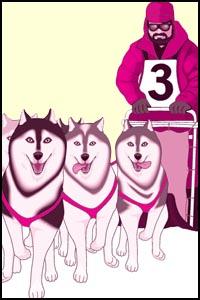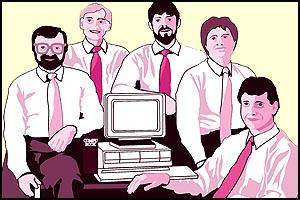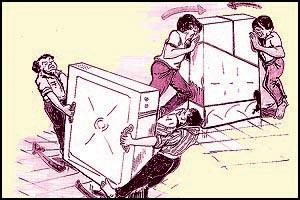
Introduction
To gain a better understanding of any organisation - be it profit or non-profit, governmental or non-governmental - it should be looked upon as a system. Modern management treats a manufacturing or service organisation as a system. A hospital is a system, an educational institution is a system, a voluntary organisation is a system, so is a spiritual organisation. Each system is made up of different components, interlinked with one another. An educational institution has teaching staff, students, curricula, support staff and proper facilities among its components. A business organisation has departments like production, marketing, finance, personnel, sales and purchase among its components. The components of a system are interdependent. Each component is busy with its functional roles to meet the targets, but at the same time it strives to achieve the corporate goal, the organisational goal. In a system approach, no component is supposed to display the behaviour which is in conflict with the organisational goal. All these components or sub-systems are manned by people, even if the entire system is either automated or computerised. Therefore, any organisation is essentially made up of people working at different levels, with different roles. Their job assignments and roles are interdependent. Their individual knowledge and skills have to be integrated to achieve the common goal. It is, therefore, imperative for them to work as a team or teams. They have to generate an attitude that constantly reminds them that the success of the organisation requires that they cooperate with each other. In other words, they work as a team.
John R. Katzenbach and Douglas K. Smith, in their work entitled The Wisdom of Teams: Creating The High-Performance Organisation (Harvard Business School Press, 1993), defines a team as, "A small number of people with complementary skills who are committed to a common purpose, performance goals and approach for which they hold themselves mutually accountable."
Basic Skills for Teamwork
Merely getting people together in the organisation does not create a team. They have to remain together for a common goal, and for that they should have different skills.
(a) Interpersonal Skills
Anywhere in any organisation, we have to deal with people: people of varying temperaments, varying intellectual levels and varying status. The team members should have an ability to get along with each other. The lack of personal-interpersonal skills on the part of even a single member would prove costly for the organisation, as it disrupts and distracts the energies of the whole team.
(b) Functional Skills
Team members should have enough knowledge and experience for the work assigned to them. For example, any team involved in developing CDs and VCDs for different events should have technical skills.
(c) Communication Skills
Team members should be able to encode and transmit the message via face-to-face communication or telephone or e-mail/voice mail or letter or the video conference, that facilitates the interaction between the sender and receiver, resulting into shared understanding and cooperation.
(d) Decision-Making Skills
They should have the ability to collectively identify the different courses of action possible and through open discussion, arrive at the optimal course of action. They can take help of certain techniques like brainstorming and multivoting to sharpen the decision-making process.
 (e) Problem Solving Skills
(e) Problem Solving Skills
Problems are inherent in any organisation. Team members should have the capability of identifying the problem, defining it, identifying the probable causes, thinking of alternative actions to eliminate the causes, selecting the best alternative and implementing it.
Values for Teamwork
Unless the team holds certain values, it develops blame-game and faultfinding strategies that ultimately destroy the team and frustrate the goal. Some basic values for teams are as follows:
(i) Togetherness
With a strong feeling of togetherness, if something goes wrong, no one will blame anyone. Rather, the team members would jointly mull over the problem and try to identify the pitfalls and correct them. If they succeed the honour is shared and everyone earns praise and recognition.
(ii) Equality
For any system to function it is imperative that some hierarchy be defined. Some members of the team perform the supervisory roles, whereas some work as subordinates. But the attitude, by and large, should be of equality. The designations should not be barriers to the work to be accomplished by the team. Such attitude of equality facilitates the upward and downward communication and generates cohesiveness.
(iii) Empathy
Empathy is a step beyond sympathy. Having empathy means seeing the world proactively, from the viewpoints of others. You have an appreciation for their problems, pains and perplexities. Any situation is evaluated by putting yourself into their position and seeing from their viewpoint. Showing empathy for your teammates earns their empathy for you. This value strengthens the bonds amongst team members, who, with double the vigour, join hands to achieve the common goal.
Once a name of a companion sadhu (jod) was to be suggested. The co-ordinator sadhu of that region suggested one name to Pramukh Swami Maharaj, who had the name of another sadhu in mind. The co-ordinator sadhu, in utmost good faith, thought that the sadhu suggested by Swamiji would prove more useful for some other region. And therefore, very humbly, he sought Swamiji's guidance. Swamiji said, "Look, we should think from that sadhu's angle as to what sort of help and support he thinks he would expect from the companion sadhu. We define the suitability or capability of somebody in our own way, ignoring his preference for and expectation from a companion sadhu, to better accomplish his work." Pramukh Swami Maharaj is empathetic.
Typology of The Teams
There are different types of teams:
(1) Action Team
As its name suggests, this team is supposed to take action under the direction of top management, to modify the old work processes to redesign or re-engineer them, or install new work processes. The evaluation is concurrent to action. Therefore these teams take periodic reviews of the actions undertaken, evaluate them, receive feedback, and re-engineer the procedures and processes. The action teams have a very strong 'can do' attitude.
(2) Policy Framing Team
These teams exist at the higher levels of management of the organisation. The policies formulated and framed by them have an impact on the entire organisation.
(3) Problem Solving Team
These teams first try to dissect the problem into sub-problems, prioritize them, analyse them and then recommend appropriate action to higher management. The members of such teams should be creative enough to generate ideas and insights. They should be able to conduct brainstorming sessions.
(4) Functional Team
The teammates of a functional team work together in a single section or a department or a functional area to generate some output. The functional team is employed in the section or department where specific skill or work knowledge is required. Compared to other individuals, they ensure more efficiency and output.
(5) Cross-Functional Team
The members of a cross-functional team, drawn from different functional areas of an organisation, strive to work for common goals. Because of the unique combination of experience, background, knowledge and skills, these teams bring innovations, simplify processes and help solve complicated problems.
(6) Self-Directed Work Team
The members of a self-directed work team are often cross-trained in multiple skills, so much so that they can carry out one another's job efficiently. The self-directed teams are supposed to do all managerial functions i.e. planning, organising, coordinating, implementing and controlling the project assigned to them. Big business organisations benefit from their self-directed work teams in terms of cost-reduction and higher productivity. These teams enjoy absolute autonomy; they have very strong esprit de corps (sense of belonging and loyalty).
Team Building
Teams do not abruptly become the most efficient or high-performing teams. A fair amount of time and effort goes into the learning process for the members of a team. Before attaining the status of a high-performing team, it has to be trained in various areas. Tuckman and Jensen, the renowned psychologists, have identified five phases of team evolution:
(a) Forming
It is the preliminary stage of a team. Here the members of a team are like strangers in an elevator. They start to feel one another out, get to know each other. No one is sure who is going to do what. Goals are ill-defined and unclear. They ask questions about what their task is and how they would organise their efforts to achieve it. This forming stage is very important because if the team can articulate a clear sense of purpose for itself, it would serve as a sound basis for the rest of the stages to follow. Some experts in organisational structure term it as the 'dependency stage'.
(b) Storming
At this stage, they begin to have a feel of their tasks. They begin to realise that it is not all smooth sailing to achieve the tasks and therefore they become a little defensive. It is like a learning stage in golf. You are introduced to the game and now you want to play around - sometimes hitting it squarely and straight and sometimes not. You enter into skirmishes also, because the two members would like to work on the same task or they disagree on goals. They try to stick to their own views, without listening to what others have to say. In the beginning, though they do not adjust much, slowly and gradually they move a little forward in knowing more about each other. This stage is termed by some organisational behaviour scientists as the 'counterdependency' stage. This stage may persist for a long period. The team members have to have patience.
(c) Norming
Team members at this stage have become mature enough to accept each other, their role and their norms. They start behaving in a manner that everyone in a group admits it as appropriate. They start interacting with each other and helping each other. The progress towards achieving the common goal now is visible and measurable. They come closer and start thinking as a team, as a whole and not as individuals. This is known as the stage of 'cohesion'.
start behaving in a manner that everyone in a group admits it as appropriate. They start interacting with each other and helping each other. The progress towards achieving the common goal now is visible and measurable. They come closer and start thinking as a team, as a whole and not as individuals. This is known as the stage of 'cohesion'.
(d) Performing
Now at this stage the members behave like mature people. They are comfortable with each other. They interact effectively with each other and communicate. They offer their own views, but at the same time they patiently listen to the views of others. There is synergy in the team now; wherein they, as a team, accomplish far more than they can as individuals. The team performs at an optimum level.
In order that the performing teams remain continually progressive, the organisation should have a set of values and a supportive culture, in the absence of which, in the longer run, the teams may become complacent and cease to grow or even decline. The performing stage is also described as the 'stage of interdependency'.
(5) Adjourning
Some teams in the organisation, depending on their roles, may never adjourn. But the teams like Action Teams  or Problem Solving Teams, having fulfilled their tasks, must be adjourned. The services of these teams, should, of course, be duly appreciated and recognised by the top management by felicitating them or arranging a thanks-giving function. Such a gesture would strengthen their bonds with the organisation.
or Problem Solving Teams, having fulfilled their tasks, must be adjourned. The services of these teams, should, of course, be duly appreciated and recognised by the top management by felicitating them or arranging a thanks-giving function. Such a gesture would strengthen their bonds with the organisation.
Conclusion
Team members always look up to the team leader. The team leader has to be a facilitator, inspirer, motivator, counsellor, conflict resolver and a communicator. He has to be a role model for the members of the team. If a team is compared to a tree, the mutual trust and faith are its roots. The leader pours his unmixed love to the roots and nurtures the tree. The leader has equal regard for his team, task and individual and strives hard to see to it that all of them flourish. The leader does not say, "Do this, Do that." He says, "Let us do this."
The leader has to often deal tactfully with dissenters and naysayers. He has to sometimes deal with the talented mavericks, who simply refuse to march in the teamwork parade.
The true leader has great appreciation and recognition for team members and teamwork. Once the late Ex-Finance Minister of India Shri H.M. Patel, admiring Pramukh Swami Maharaj's achievements said, "Swamiji, the kind of work that you have been accomplishing is simply amazing." With utmost humility, Swamiji replied, "The entire planning is done by our learned sadhus. I simply adorn the chair, the real work is put in by our sadhus and devotees."
The task of conducting a meeting of the teammates makes a team leader wear a cap of facilitator, monitor, motivator, guide, evaluator, inspirer and summarizer - all at the same time. He directs the discussion, listens to everyone, at times suppresses secondary discussion or 'noise', and wraps up the things effectively, giving the feeling of 'a productive meeting' to all the teammates.
In one meeting of BAPS accountants, Pramukh Swami Maharaj cleared 65 items within 60 minutes, to the utmost satisfaction of all participants!
Prior to any meeting, Pramukh Swami Maharaj invariably reads the minutes of the previous meeting. Pointedly he asks about the works accomplished within the stipulated period and the works not yet accomplished. He would enquire about the reasons for the delay and then offer wonderful counselling, particularly on matters related to accounting, administration, law, construction projects and planning.
Higher productivity, higher efficiency, economy, inculcating a sense of belonging and building up a corporate image are some of the fruits of teamwork for any organisation. Rightly, someone said, "TEAM means Together Everyone Achieves More." Truly, as 'truth triumphs', teamwork also triumphs.